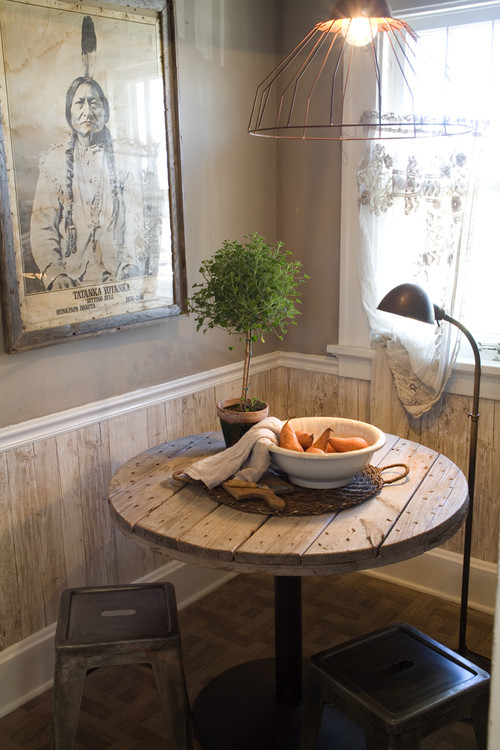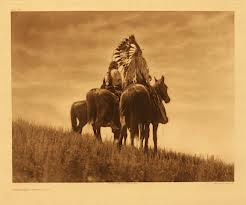Here are some great examples of Curtis' photographs and use of them in interior decorating. You can find his prints and posters online at any of the major art sites.

Eclectic Living Room design by Dallas Media And Blog The Cavender Diary

 |
| Ralph Lauren |
 |
| Architectual Digest |

Small dining design by curioussofa.com for Romantic Homes magazine 2008 - Not Curtis but cool idea
 |
| Greenvalleyranchmontana.com Wikipedia.org info below: Edward Sheriff Curtis (February 16, 1868 – October 19, 1952) was an ethnologist and photographer of the American West and of Native American peoples. Edward Curtis was born on a farm near Whitewater, Wisconsin. Around 1874 the family moved from Wisconsin to Minnesota to join Johnson Curtis's father, Asahel Curtis, who ran a grocery store and was a postmaster in Le Sueur County. Curtis left school in the sixth grade and soon built his own camera.
In 1885 at the age of seventeen Edward became an apprentice photographer in St. Paul, Minnesota. In 1887 the family moved to Seattle, Washington, where Edward purchased a new camera and became a partner in an existing photographic studio with Rasmus Rothi. Edward paid $150 for his 50 percent share in the studio. After about six months, Curtis left Rothi and formed a new partnership with Thomas Guptill. The new studio was called Curtis and Guptill, Photographers and Photoengravers.
In 1895 Curtis met and photographed Princess Angeline (c. 1800–1896), aka Kickisomlo, the daughter of Chief Sealth of Seattle. This was to be his first portrait of a Native American. In 1898, three of Curtis' images were chosen for an exhibition sponsored by the National Photographic Society. Two were images of Princess Angeline, "The Mussel Gatherer", and "The Clam Digger". The other was of the Puget Sound, titled "Homeward". The latter was awarded the exhibition's grand prize and a gold medal. In that same year, while photographing Mt. Rainier, Curtis came upon a small group of scientists. One of them was George Bird Grinnell, an expert on Native Americans. Curtis was appointed Official Photographer to the Harriman Alaska Expedition of 1899, probably as a result of his friendship with George Bird Grinnell. Having very little formal education Curtis learned much during the lectures that were given aboard the ship each evening of the voyage. Grinnell became interested in Curtis' photography and invited him to join an expedition to photograph the Blackfeet Indians in Montana in the year 1900.
In 1906 J. P. Morgan provided Curtis with $75,000 to produce a series on the North American Indian. This work was to be in 20 volumes with 1,500 photographs. Morgan's funds were to be disbursed over five years and were earmarked to support only fieldwork for the books not for writing, editing, or production of the volumes. Curtis himself would receive no salary for the project, which was to last more than 20 years. Under the terms of the arrangement, Morgan was to receive 25 sets and 500 original prints as his method of repayment.
Once Curtis had secured funding for the project, he was able to hire several employees to help him. For writing as well as with recording Native American languages, Curtis hired a former journalist, William E. Myers. For general assistance with logistics and fieldwork, Curtis hired Bill Phillips, a graduate of the University of Washington. Perhaps the most important hire for the success of the project was Frederick Webb Hodge, an anthropologist employed by the Smithsonian who had also researched Native American peoples of the southwestern United States. Hodge was hired to edit the entire series.
222 complete sets were eventually published. Curtis' goal was not just to photograph, but to document, as much American Indian (Native American) traditional life as possible before that way of life disappeared. He wrote in the introduction to his first volume in 1907: "The information that is to be gathered ... respecting the mode of life of one of the great races of mankind, must be collected at once or the opportunity will be lost." Curtis made over 10,000 wax cylinder recordings of Indian language and music. He took over 40,000 photographic images from over 80 tribes. He recorded tribal lore and history, and he described traditional foods, housing, garments, recreation, ceremonies, and funeral customs. He wrote biographical sketches of tribal leaders, and his material, in most cases, is the only written recorded history although there is still a rich oral tradition that documents history. This work was exhibited at the Rencontres d'Arles festival (France) in 1973.
Curtis had been using motion picture cameras in the fieldwork for The North American Indian since 1906. He worked extensively with ethnographer and British Columbia native George Hunt in 1910, which inspired his work with the Kwakiutl, but much of their collaboration remains unpublished. At the end of 1912, Curtis decided to create a feature film depicting Native American life, partly as a way of improving his financial situation and partly because film technology had improved to the point where it was conceivable to create and screen films more than a few minutes long. Curtis chose the Kwakiutl tribe of the Queen Charlotte Strait region of the Central Coast of British Columbia, Canada, for his subject. This film, titled In the Land of the Head Hunters, was the first feature-length film whose cast was composed entirely of Native North Americans.
In the Land of the Head-Hunters premiered simultaneously at the Casino Theatre in New York and the Moore Theatre in Seattle on December 7, 1914. The silent film was accompanied by a score composed by John J. Braham, a musical theater composer who had also worked with Gilbert and Sullivan. The film was praised by critics but made only $3,269.18 in its initial run.
Around 1922 Curtis moved to Los Angeles with his daughter Beth, and opened a new photo studio. To earn money he worked as an assistant cameraman for Cecil B. DeMille and was an uncredited assistant cameraman in the 1923 filming of The Ten Commandments. On October 16, 1924 Curtis sold the rights to his ethnographic motion picture In the Land of the Head-Hunters to the American Museum of Natural History. He was paid $1,500 for the master print and the original camera negative. It had cost him over $20,000 to film.
In 1927 after returning from Alaska to Seattle with his daughter Beth, he was arrested for failure to pay alimony over the preceding 7 years. The total owed was $4,500, but the charges were dropped. For Christmas of 1927, the family was reunited at daughter Florence's home in Medford, Oregon. This was the first time since the divorce that Curtis was with all of his children at the same time, and it had been thirteen years since he had seen Katherine. In 1928, desperate for cash, Edward sold the rights to his project to J.P. Morgan's son. In 1930 he published the concluding volume of The North American Indian. In total about 280 sets were sold of his now completed opus magnum. In 1930 his ex-wife, Clara, was still living in Seattle operating the photo studio with their daughter Katherine. His other daughter, Florence Curtis, was still living in Medford, Oregon with her husband Henry Graybill. After Clara died of heart failure in 1932, his daughter Katherine moved to California to be closer to her father and her sister Beth.
In 1935 the Morgan estate sold the rights and remaining unpublished material to the Charles E. Lauriat Company in Boston for $1,000 plus a percentage of any future royalties. This included 19 complete bound sets of The North American Indian, thousands of individual paper prints, the copper printing plates, the unbound printed pages, and the original glass-plate negatives. Lauriat bound the remaining loose printed pages and sold them with the completed sets. The remaining material remained untouched in the Lauriat basement in Boston until they were rediscovered in 1972.
***************
In 1892 Edward married Clara J. Phillips (1874–1932), who was born in Pennsylvania. Her parents were from Canada. Together they had four children: Harold Curtis (1893–?); Elizabeth M. (Beth) Curtis (1896–1973), who married Manford E. Magnuson (1895–1993); Florence Curtis (1899–1987) who married Henry Graybill (1893–?); and Katherine (Billy) Curtis (1909–?).
In 1896 the entire family moved to a new house in Seattle. The household then included Edward's mother, Ellen Sheriff; Edward's sister, Eva Curtis; Edward's brother, Asahel Curtis; Clara's sisters, Susie and Nellie Phillips; and Nellie's son, William.
During the years of work on the "North American Indian", Curtis was often absent from home for most of the year, leaving Clara to manage the children and the studio by herself. After several years of estrangement, Clara filed for divorce on October 16, 1916. In 1919 she was granted the divorce and received the Curtis' photographic studio and all of his original camera negatives as her part of the settlement. Edward went with his daughter, Beth, to the studio and destroyed all of his original glass negatives, rather than have them become the property of his ex-wife, Clara. Clara went on to manage the Curtis studio with her sister, Nellie M. Phillips (1880–?), who was married to Martin Lucus (1880–?). Following the divorce, the two oldest daughters, Beth and Florence, remained in Seattle, living in a boarding house separate from their mother. The youngest daughter, Katherine Curtis lived with Clara in Charleston, Kitsap County, Washington.
On October 19, 1952, at the age of 84, Curtis died of a heart attack in Whittier, California in the home of his daughter, Beth. He was buried at Forest Lawn Memorial Park in Glendale, California. His terse obituary appeared in The New York Times on October 20, 1952:
|








